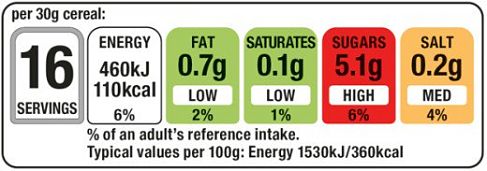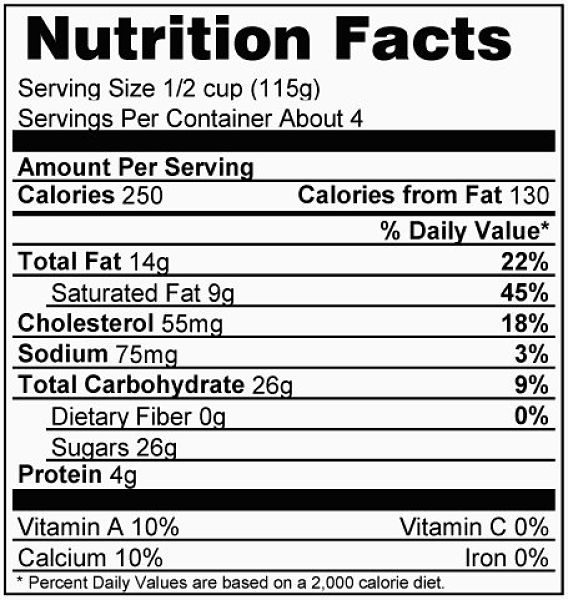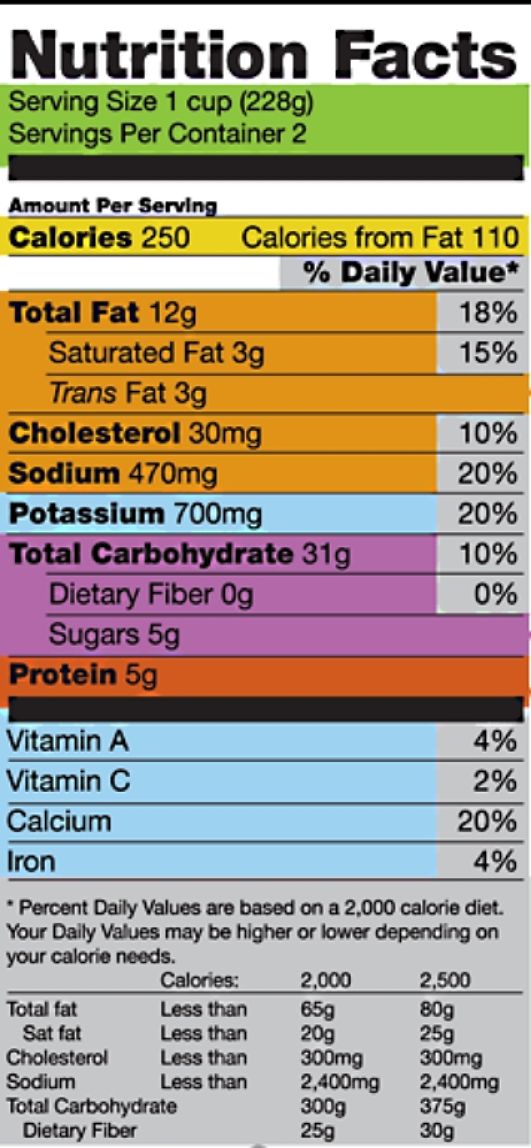Do Food Labels Inform, Educate, Deceive or Mislead - Traffic Lights Off or On
There is a lot of tail-chasing around the world at the moment as various countries are reviewing their food labelling regulations.
Most of the debate centres on whether the labels should be on the front of the pack, rather than the side or back, and whether the 'traffic lights' labelling system should be used.
A Traffic light rating system is a simple method for showing the level of a food component using the familiar 'green', 'amber' (yellow), and 'red' of traffic signals.
Food sold pre-packed can be labelled with a traffic light label that shows the proportions of saturated fats, sugar, fat and salt. The familiar traffic light signals represent scores of high ('red'), medium ('yellow') and low ('green') percentages for each of these ingredients.
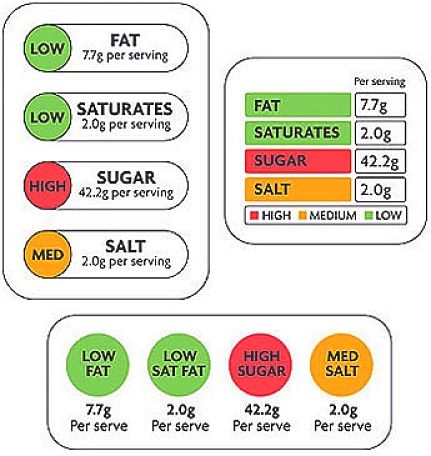
Foods with 'green' labels are generally 'healthier' and to be preferred over those with 'red' labels, with 'amber' ones in between. These labels, located on the front of the package, are much easier to see and interpret than the common Guideline Daily Amount (GDA) labelling which is generally also shown on the side, or back of the packet.
The Guideline Daily Amount (GDA) has been criticised as being very difficult for many people to understand, including children, and does not provide quick comparisons between products on the shelves.
The use of traffic light labelling is supported by many doctor groups including the British Medical Association and has been generally welcomed by consumers. A number of supermarkets and food manufacturers in the UK are using traffic light colours on the labels of some products.
However some in the food industry have expressed concern that the "red" foods would be shunned by consumers. But the Food Standards Agency and the British Medical Association and others claim that consumers generally interpret the labels sensibly. Consumers realise they can still buy and eat the red foods as a "treat". The colour coding is much easier to understand than lists of percentages.
EU Food Labels - 'Traffic Lights Switched Off'
However in June 2010 the EU switched off ‘traffic light’ food labels. The Parliament decided to adopt front-of-pack food labelling that is very similar to the system used by Australia’s food industry.
Under the EU decision, companies will now use Guideline Daily Amounts to label the energy, sugar, salt and fat content on the front of food packages, as well as protein, unsaturated fats and fibre.
This is a very similar model to Australia’s daily intake guide front-of-pack labelling system which lists the amount of energy, fat, saturated fat, sugar and salt in a recommended serve of the food and what this represents as a proportion of average daily intake.
The Australian Food Label System is shown below.
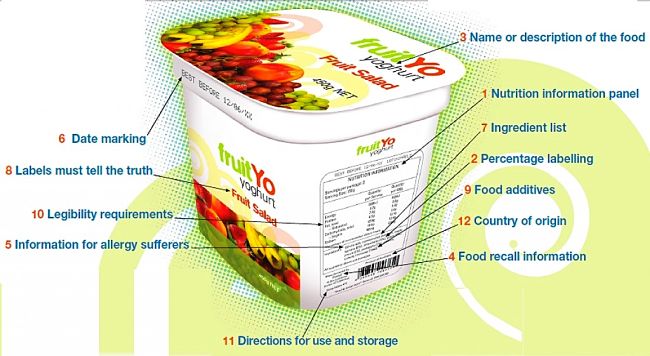
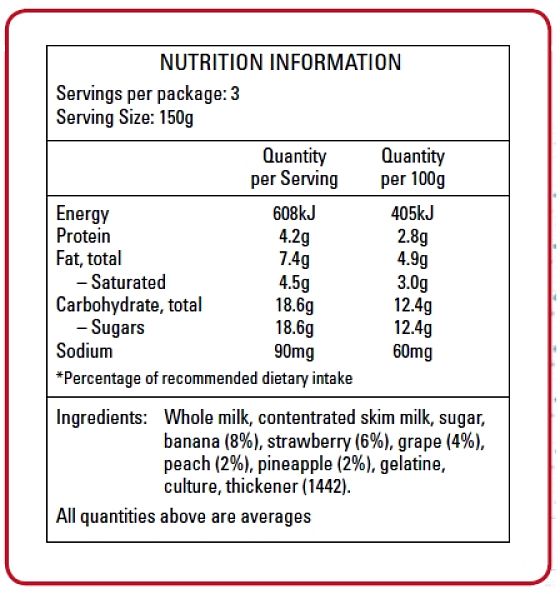

Labels in USA
In January 2011 the US food industry took pre-emptive acton in the fight over front-of-package (FOP) calorie and nutrition content labelling. It has put forth its own voluntary scheme, 'Nutrition Keys' which the industry hopes to head off the alternative and possibly much more stringent scheme yet to be developed by the US Food and Drug Administration.
In 2010, First Lady Michelle Obama requested that industry develop front-of-pack labels that could be widely adopted on food packages. These labels would help busy shoppers - especially parents - make informed decisions when they shop to choose healthier products.
The new plan — called Nutrition Keys— proposed by the Grocery Manufacturers Association and Food Marketing Institute in US, uses a multi-tab logo to display the calorie count per serving, and the amount of fat, sodium, and sugar up front.
Moving the nutrition information to the front from the back or side, where Nutrition Facts now appear, is a major improvement.
Nutrition Keys is a fact-based system for summarizing key nutrition information in a clear, simple and easy-to-use format on labels for food and beverage packages. The new icon and label changes, follow current U.S. Food and Drug Administration regulations and guidelines. The four basic icons represent key nutrients which should be limited in the diet:
- calories,
- saturated fat,
- sodium
- sugars.
The four basic icons are always presented together as a consistent set:

As an option, certain labels could include positive messages referring to “nutrients to encourage”, that is nutrients that may need supplementing to build up a “nutrient-dense” and balanced diet. Two extra “nutrients to encourage” can be added, including: potassium, fibre, protein, vitamin D, vitamin A, vitamin C, calcium and iron. These extra nutrients can only be added to a package when the product has more than 10 percent of the daily value per serving of the nutrient. Also the extra item has to meets the FDA requirement that the food is a “good source” for the nutrient.

Many have criticised this, because it shifts the emphasis from listing “the bad stuff”to the less important vitamins and other positive elements of the components.
What food makers fear most, say critics, is the US Food and Drug Administration's (FDA) power to make them list more of the “negatives” in highly-processed foods.
Others have claimed that the industry move is a blatant attempt to preempt Federal food labelling requirements. Many consumer groups view the program with skepticism, given the poor record of food manufacturers in providing nutrition information in the past. The industry’s previous initiative — Smart Choices — was scrapped in 2009 after critics complained it was too lenient and misleading.
Indeed, Smart Choices was infamous for classifying 'Fruit Loops' as a smart choice for breakfast, and listing ice cream as a health food because it was a good source of Calcium.
While Nutrition Keys is a major advance over Smart Choices, the FDA may still have the final say on the new nutrition labels.
It has been reported that the industry’s plan has received a guarded response from Mrs. Obama. This was in stark contrast to her enthusiastic support of a healthful eating initiative from Walmart, which pledged to redevelop its store-brand foods and introduce easy-to-understand labels which highlighted foods which were more healthful.
In a statement, the White House stated that the labelling initiative was a good first step but added that it would “look forward to future improvement” in the system. It said the FDA would closely review the Nutrition Keys system to assess whether it met the needs of American consumers.
The FDA has said it was interested in the British labelling system using a traffic signal logo to show unfavourable (red) and favourable (green) nutrient content. However the Food Industry has strongly resisted this system, which it fears might drive consumers away from 'red' labelled items.
Walmart Commitment to new Labels
Walmart announced in a press conference in late January 2011, that it will reduce added salt content by 25 % and added sugar content by 10 % for its home-brand food products by 2015. Walmart alaso stated that it was committed to lowering trans-fats and partially hydrogenated oils in its home-brand food products. Other parts of Wlamart's plan include:
-
Walmart will reduce or eliminate the price premium on key "betterfor-you" items, such as reduced sodium, sugar or fat products;
-
Develop strong criteria for a simple front-of-package seal that will help consumers instantly identify truly healthier food options such as whole grain cereal, whole wheat pasta or unsweetened canned fruit;
-
Providing solutions to address food deserts by building stores in under-served communities that are in need of fresh and affordable groceries; and
-
Increasing charitable support for nutrition programs that help educate consumers about healthier food solutions and choices.
The company claims the program may save consumers around $1 billion a year on the purchase of fresh fruits and vegetables.
Labels in Australia
The Australian Food labelling laws are under review and this could change the information currently on food labels (see images above). An expert panel is reviewing various aspects including whether Australia should consider simplified ''traffic light'' labels. The food industry and health groups are polarised on the traffic light display systems that would use red, amber and green to signal the level of a food product's potentially unhealthy ingredients such as fat, sugar and salt.
The food industry has dismissed the system as overly simplistic and misleading, whereas the health groups argue that such simple label systems are just what is needed to control the obesity epidemic.
It is ironic that the EU has moved away from the traffic lights system towards the Australian system, just when Australia is considering adopting them.
A recent survey by the Cancer Council of Victoria, Australia, showed that about 87 % of consumers were in favour of the traffic-light labels, while they were opposed by 77 % of the food industry submissions to the review panel.
Kate Carnell, chief executive of the Australian Food and Grocery Council, has highlighted the European Union's abandonment of traffic-light labelling in 2010. Ms Carnell said that, following the EU decision, companies would label the energy, salt, sugar and fat content on the front of food packages with guidelines for daily intake that closely resembled the current Australian system. The daily intake guide labelling system (see above) lists the amount of energy, sugar, fat, saturated fat and salt in a recommended serve of the food, and its proportion of average daily intake.
It has been reported that Europe's food industry spent more than €1 billion fighting for the demise of the traffic-light labels.
The Food Labelling Review Panel raised several issues in its recent consultation paper:
- Is it appropriate for food labelling to be used to support government health strategies such as healthy eating campaigns?
- Can the food industry be relied on to self-regulate the food labelling system?
- How can we make sure consumers can read and understand food labels?
The Consumer Advocate group 'Choice' listed several demands for better food labelling in their submission to the review, including:
-
Traffic light labels for fats, sugars, and sodium to support government preventive health measures and help consumers to make healthy food choices at a glance.
-
An end to dubious and unsubstantial marketing claims about nutrition content and health benefits of sugary, salty and fatty foods.
-
Expose hidden ingredients such as palm oil (on ingredients lists) and trans fats (on ingredients lists and nutrition information panels, and provide more informative additive and allergen information for consumers who need to avoid particular ingredients.
-
Informative country of origin labels that help consumers to identify where key ingredients (fruit, vegetables, meat etc) have come from.
-
Trustworthy information about food production methods and new technologies, including GM foods and nantechnology.
-
Better standards for addressing Tree-range' and 'organic' claims.
-
A regulatory approach to food labelling that: Maintains government responsibility for food labelling and consumer confidence in food labelling and the food supply; and is effectively and consistently enforced by a single national regulator.
Arguments Supporting the Traffic Lights Food Labelling System
It has been argued that while the Australian Nutrition Information Panel (NIP) is an excellent resource for health professionals and for the better educated and highly motivated consumers, it has the following usage problems:
- It is too time consuming for most adults to use
- It is also too difficult for adults with limited numeracy or literacy, including those from a non-English speaking background.
- It is too difficult for most children to use
Similar usage issues apply to the Percentage Daily Intake Labelling system put forward by the food industry.
The suggested advantages of the Traffic Light Labelling system are:
- It is intuitive, easily understood way of conveying information on healthy food choices.
- It is much easier to compare food items on the shelves using the colours, rather than having to read the details of the labels
- Almost all people (including young children) understand the significance of red, amber, and green traffic lights,
- It is a much better guide for people to select foods to meet their requirements, and aligns with advice given on healthy diets
- It can have a significant effect on the behaviour of consumers and will help them moderate their intake of foods high in fat and sugar.
- A general educational campaign could be based on the system aimed at convincing people of the benefits of healthy eating and ways to avoid of obesity. The traffic light labelling of foods provides a user-friendly tool to enable the good intentions and advice to be put into practice.
Are the Traffic Lights to go Off or ON for Food Labels Worldwide?
UPDATE:
Australia gets a new Food Labels Hierarchy and a Traffic Lights System
The Review Panel conducting the Independent Review of Food Labelling Law and Policy in Australia released its report on 28 January 2011 entitled:
Labelling Logic
The recommendations are built on a risk based Food Labelling Issues Hierarchy, in descending order of priority from food safety, preventative health, new technologies and consumer values issues. The diagram below illustrates where rules and oversight should lie and provides the basis for the recommended Principles to guide food labelling decisions. The Report recommends a range of regulatory interventions based on this hierarchy, ranging from mandatory, through co-regulation and self-regulation.
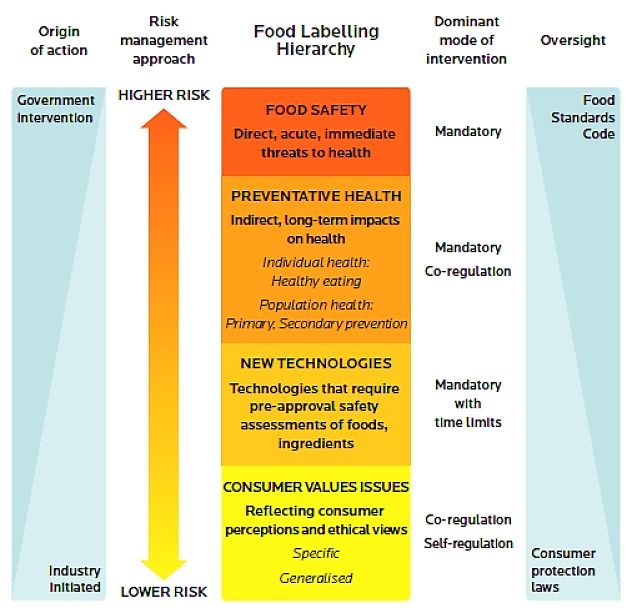
TRAFFIC LIGHTS SYSTEM FOR AUSTRALIA
The use of interpretative symbols or endorsements on labels has the potential to convey essential nutrition information when included as one of multiple strategies to facilitate healthy eating choices . As there is now a growing consensus between industry, consumers, health advocacy groups and governments in favour of front-of-pack labelling, the issue before the Panel was what form it should take. The Panel recommends that a multiple traffic lights (MTL) front-of-pack labelling system be introduced. Such a system is to be voluntary in the first instance, except where general or high level health claims are made or equivalent endorsements/trade names/marks appear on the label, in which case it should be mandatory. The Panel also recommends that chain food service outlets across Australia and New Zealand be encouraged to display the MTL system on menus/menu boards, but that beverages containing alcohol be exempt from any MTL requirements.
Recommendation 50: That an interpretative front-of-pack labelling system be developed that is reflective of a comprehensive Nutrition Policy and agreed public health priorities.
Recommendation 51: That a multiple traffic lights front-of-pack labelling system be introduced. Such a system to be voluntary in the first instance, except where general or high level health claims are made or equivalent endorsements/trade names/marks appear on the label, in which case it should be mandatory.
Recommendation 52: That government advice and support be provided to producers adopting the multiple traffic lights system and that its introduction be accompanied by comprehensive consumer education to explain and support the system.
Recommendation 53: That ongoing monitoring and evaluation of the multiple traffic lights system be undertaken to assess industry compliance and the effectiveness of the system in improving the food supply and influencing consumers' food choices.
Recommendation 54: That chain food service outlets across Australia and New Zealand be encouraged to display the multiple traffic lights system on menus/menu boards. Such a system be mandatory where general or high level health claims are made or equivalent endorsements/trade names/marks are used.
Recommendation 55: That any beverages containing alcohol be exempt from nutrition-related front-of-pack labelling requirements.
Recommendation 56: That the potential of new information technologies be considered by consumer organisations, industry and government to provide extended product labelling for non-mandatory information.
The Major Findings for the Traffic Lights System
Among the competing Food Labelling Systems that have been tested in Australia, New Zealand and elsewhere, the colour-coded multiple traffic lights (MTL) system has been consistently found to be most effective in facilitating consumers' understanding of the nutrient profiles of foods within and across food categories.
The MTL system comprises coloured 'lights' for key nutrients - a green light signifies a healthy choice, an amber/orange light an 'okay' choice and a red light a less healthy or unhealthy choice. There are various forms of the MTL system, some with words (e.g., low/medium/high) or numbers (e.g., nutrient amounts per serving) associated with each light.
Many of the submissions from consumers, consumer groups and health groups expressed strong support for the MTL system. Of particular note is the Public Health Association of Australia's submission representing more than 40 public health promotion organisations. This submission noted that the implementation of a MTL system 'would enable all Australians and New Zealanders to make instant decisions on the healthiness of food and drink products, limit the need for extensive use of nutrition knowledge at the point of purchase and be available for use by all Australians regardless of literacy and numeracy skills.
The MTL system has been found to be most beneficial for those who are less skilled at utilising the NIP, thus providing nutrition information
to those who are least able to access it in other ways. The MTL system is also a useful aid to health professionals when providing clients with dietary advice.
The MTL system has achieved some familiarity in the marketplace due to its wide use in school canteens in Australia and New Zealand. The forthcoming Australian Department of Education's National School Canteen Policy is based specifically on traffic lights and some States (e.g., Western Australia and Queensland) have also introduced guidelines for health facilities that are based on traffic lights. Similar policies are currently being developed for sporting venues. The evaluation of the Western Australia school canteen policy, which has been in effect since 2007, found that around one in four parents reported translating their traffic light knowledge to their supermarket purchases. This illustrates the synergies that could be generated if a mandatory, standardised system is implemented across food purchase domains.
Related Articles
=> Wine Making Ingredients and Additives Not Revealed on Labels
=> Q&A: Generic Brands, Home Brand and Private Label Food Products
=> New Food Label Uses a Fuel Gauge Concept for Daily Calorie Allowances
=> Food Nutrition Labels - Fact or Fiction
